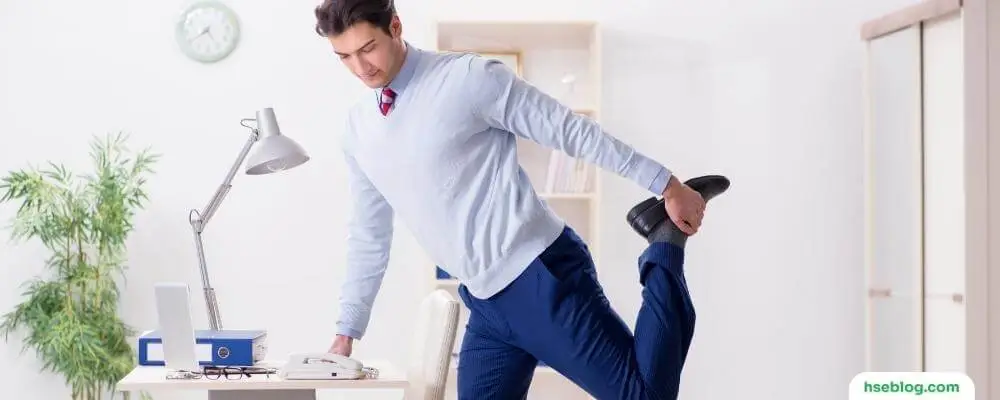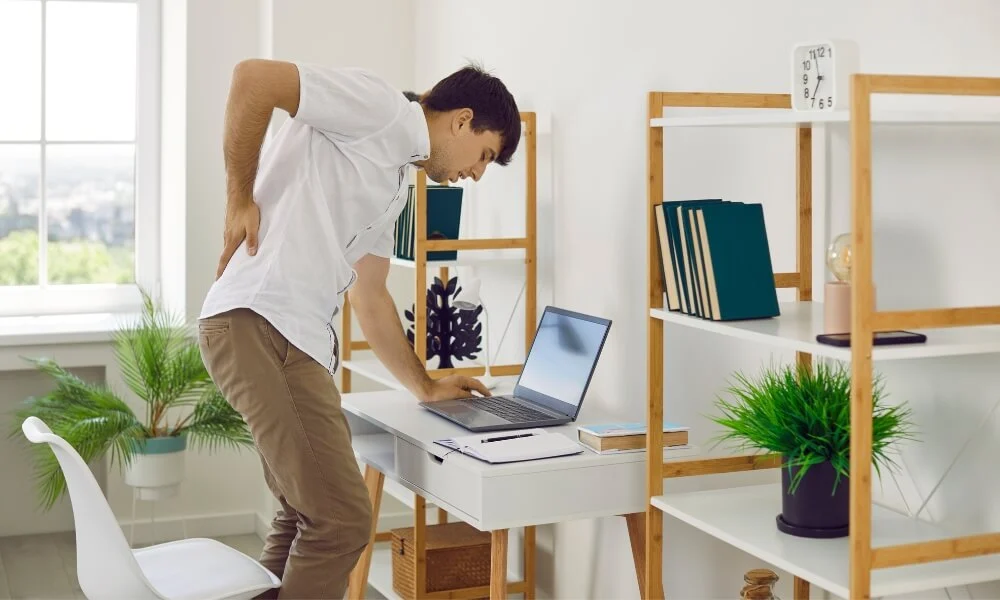In today’s fast-paced and technology-driven world, ensuring a safe and productive work environment is essential. One key aspect of achieving this is understanding and addressing ergonomic hazards. Ergonomics focuses on the relationship between people and their work environment, aiming to optimize health and performance.
This comprehensive guide will explore 15 ergonomic hazards commonly found in workplaces and discuss effective control measures to mitigate their impact. From poor workstation design and height to frequent lifting, slippery surfaces, and more, we will uncover the potential risks that can lead to discomfort, injuries, and reduced productivity.
Understanding ergonomic hazards is just the first step. We will also provide insights into various control measures to create a safe and healthy work environment. These measures encompass engineering controls that modify the physical aspects of the workspace, administrative controls that introduce changes in work practices and policies, and the use of personal protective equipment (PPE).
By implementing the appropriate control measures, businesses can enhance the well-being and performance of their employees, reduce the risk of work-related injuries, and create a more productive work environment overall.
Ergonomics Hazards
Ergonomic hazards are physical environmental factors that can harm the musculoskeletal system. They include any tasks that require you to perform movements that place an undue amount of strain on your body, particularly your muscles and joints. Here’s a breakdown of the ergonomic hazards that were mentioned in the shared content:
1. Workstation Design and Height
The significance of proper workstation design and height cannot be overstated. A well-structured workstation optimizes an individual’s productivity while ensuring their physical health is not compromised. When a workstation is too high or too low, it necessitates adopting awkward postures such as stooping, craning the neck, or overreaching. The musculoskeletal system is under significant stress, particularly the back, neck, and shoulders. Over time, these unnatural postures can give rise to chronic musculoskeletal disorders.
Furthermore, an inadequately designed workstation may lack sufficient space for free movement, exacerbating the issue. Optimal workstation design should consider the tasks performed, tools and equipment used, and the physical attributes of the person using it. By adjusting the height and arrangement of work surfaces, providing adjustable chairs, and ensuring adequate space for movement, one can prevent undue strain on muscles and joints.

2. Lighting
Lighting plays an essential role in any work environment. Insufficient or excessive lighting affects the ability to perform tasks efficiently and without strain. Poor lighting can cause eye strain, headaches, and fatigue, leading to decreased productivity and a higher likelihood of errors. Furthermore, inadequate lighting often leads to adopting compensatory postures to see better, such as leaning forward or squinting, which in turn causes neck and back strain.
Alternatively, excessively bright lighting can cause glare on screens, again leading to eye strain and discomfort. Proper lighting design considers the task’s nature and the visual requirements involved. This includes selecting appropriate light sources, ensuring even distribution, and providing options for adjusting brightness according to individual preferences. Natural light should be maximized wherever possible, as it has been shown to improve mood and productivity.
3. Noise
The impact of noise on employee well-being and productivity is multifaceted. In a noisy work environment, employees may find it difficult to concentrate, communicate, and perform tasks that require careful attention. Continuous exposure to high noise levels can lead to elevated stress levels, which, over time, can adversely affect mental health. Moreover, exposure to excessive noise levels can lead to noise-induced hearing loss, a permanent and irreversible condition. Such auditory damage can significantly impact an individual’s quality of life.
Beyond hearing loss, noise is a known stressor that can contribute to cardiovascular diseases due to the stress it places on the body. Employers should strive to minimize noise levels through proper workspace design, using noise-reducing materials, and providing personal protective equipment when necessary. Additionally, creating quiet spaces where employees can retreat to concentrate on tasks or relax can be beneficial.
4. Badly Placed Keyboards and Monitors
Proper placement of keyboards and monitors is imperative to prevent repetitive strain injuries. When keyboards are positioned too high, too low, or too far away, it necessitates reaching and straining the wrists and arms. This can lead to conditions such as carpal tunnel syndrome. Similarly, monitors placed at inappropriate heights or distances force the neck into unnatural positions.
Monitors that are too low cause the person to look down for extended periods, while monitors that are too high can lead to looking up for too long – both positions strain the neck. These conditions can cause chronic pain, reduce the range of motion, and impact productivity and quality of life. An ergonomic assessment should ensure that the keyboard and monitor are placed so that the wrists are neutral and the top of the monitor screen is at eye level. Adjustable stands and armrests can facilitate customization.
5. Sedentary Work
The modern work culture often involves prolonged periods of sitting, which has been dubbed “the new smoking” due to its detrimental health effects. Sedentary behavior leads to muscle atrophy, particularly in the legs and glutes. It also reduces metabolism and increases the risk of obesity, diabetes, and cardiovascular diseases. Besides, sitting for extended periods, especially in a non-ergonomic chair, can cause lower back pain and strain the spinal structures.
Employers should encourage a more active work environment through adjustable sit-stand desks, regular breaks for stretching, and promoting walking meetings. Additionally, educating employees on the importance of postural variations and movement is key.

6. Slippery Surfaces
Workplaces may overlook the importance of maintaining floors free from slip hazards. However, slippery surfaces are a leading cause of workplace injuries. A fall from a slippery surface can range from mild to severe, with potential outcomes including sprains, fractures, or even head injuries. Such incidents not only affect the well-being of the employees but can lead to lost productivity and financial burdens on both the individual and the organization.
Employers should ensure that floors are kept clean and dry, that spills are promptly addressed, and that mats or non-slip surfaces are used where necessary. Moreover, clear communication regarding potential slip hazards and educating employees on safe practices can contribute to reducing such incidents.
7. Equipment Layout and Operation
Equipment layout within a workspace is often an overlooked aspect of ergonomics. The proper arrangement necessitates minimizing excessive reaching, twisting, or other awkward movements. Equipment placed in hard-to-reach areas or requiring repetitive or forceful motions increases the musculoskeletal strain and injury risk. This, in turn, can lead to chronic pain, reduced mobility, and impaired ability to perform work tasks.
Furthermore, inefficient layouts can decrease productivity as more time and effort are required to perform basic tasks. Employers should ensure that the equipment layout is intuitive, minimizes movement, and is adjusted according to the specific needs of each employee. Moreover, equipment operation should be assessed for ergonomic design to minimize repetitive or forceful actions.
8. Messy Cables
In the modern workspace, cables are ubiquitous, but they can present a significant hazard if not managed properly. Cables strewn across the floor or in high-traffic areas are an eyesore and a tripping hazard. When an employee trips over a cable, they risk a fall and the sudden, awkward movements that can result in muscle and joint strain. This could lead to immediate injury or contribute to the development of chronic musculoskeletal problems.
Moreover, a trip and fall incident can have psychological effects, making employees feel less safe in their work environment. Cable management solutions should be employed to keep cables organized and out of the way. This could include cable ties, conduits, or trays that keep cables off the floor.
9. Inadequate Task Chairs
An ergonomic chair is essential for those who spend most of their workday sitting. A chair that does not offer the necessary support and adjustability can lead to poor posture, which can cause lower back pain, neck strain, and other musculoskeletal problems over time. Additionally, sitting in an uncomfortable chair can decrease concentration and productivity.
An ergonomic chair should have adjustable height, seat depth, and lumbar support to accommodate the spine’s natural curvature. Moreover, it should have adjustable armrests to support the arms and reduce the strain on the shoulders and neck. Employers should prioritize providing chairs that meet these criteria and educate employees on adjusting them to suit their needs.
10. Frequent Lifting
Tasks involving lifting objects, particularly heavy or bulky ones, commonly cause workplace injuries. Lifting requires a significant amount of force, which can cause strain to the back, shoulders, and legs. Frequent lifting, especially with improper form, can lead to acute injuries such as sprains or chronic conditions like herniated discs.
Training employees in proper lifting techniques is essential. This includes bending at the knees, keeping the load close to the body, and avoiding twisting while lifting. Additionally, mechanical aids should be provided where possible to minimize the physical effort required. Regular risk assessments should also be conducted to identify and mitigate hazards associated with lifting tasks.

11. Awkward Movements
Performing tasks that involve awkward movements, such as twisting, bending, or reaching, can significantly strain the musculoskeletal system. When these movements are repetitive or involve force, the risk of injury increases. For example, a worker repetitively reaching behind or twisting to grab items may develop chronic back or shoulder pain.
Moreover, these movements may cause injuries such as muscle strains or ligament sprains. It’s vital to assess the workspace and task designs to minimize the necessity of these movements. Adjusting shelf heights, providing tools with longer handles, and training on safer body mechanics can help reduce the risks associated with awkward movements.
12. Vibration
Workers who regularly use vibrating tools or machinery are at risk of developing Hand-Arm Vibration Syndrome (HAVS). This condition, characterized by a range of symptoms, including tingling, loss of sensation, and in severe cases, the loss of finger function, is caused by damage to blood vessels, nerves, and joints in the hands and arms due to repeated exposure to vibration.
Measures to mitigate this hazard include providing anti-vibration gloves, ensuring machinery is well-maintained to reduce vibration levels, and limiting the duration of exposure to vibrating tools.
13. Extreme Temperatures
Working in environments with extreme temperatures, be it very hot or cold, can harm the musculoskeletal system and general health. Cold environments can reduce blood flow, causing muscle stiffness and an increased risk of strains and sprains. In contrast, hot environments can lead to fatigue, decreased muscle strength, and an increased risk of heat-related illnesses. To mitigate these risks, employers should provide appropriate clothing, allow for more frequent breaks, and ensure that workspaces are well-ventilated and heated as necessary.
14. Conditions Involving Direct Pressure
Tasks that involve leaning against hard surfaces or applying direct pressure to body parts can lead to injuries such as bruises, pressure sores, or nerve damage. For example, an assembly line worker who leans against a hard surface might experience discomfort, pain, or numbness. Employers should provide padding for surfaces that employees might lean against and educate employees on the importance of shifting positions regularly.
15. Exerting Excessive Effort or Force
Jobs that require the exertion of high levels of physical force significantly strain the musculoskeletal system. Pushing, pulling, or carrying heavy objects without proper mechanical assistance or technique can lead to acute injuries like sprains, strains or chronic injuries like joint degeneration. Employers must assess tasks for force requirements and implement strategies such as using mechanical aids, team lifting strategies, or redesigning tasks to reduce the levels of force required.

Also Read
Types Of Ergonomics And Examples
Explore types of ergonomics and real-world examples to improve comfort, efficiency, and health in various environments.

Different Ergonomics Hazards Control Measures
Controlling ergonomic hazards is essential to maintain a safe and productive work environment. There are three main control measures: Engineering Controls, Administrative Controls, and Personal Protective Equipment (PPE).
1. Engineering Controls
These involve physical workplace or job changes that reduce or eliminate the hazard. They are the most effective control method, targeting the hazard at its source. Examples include:
- Redesign of Workstations: Adjust workstations, like desk height or chair design, to fit the worker’s anthropometry and arrange things so everything is within easy reach.
- Use of Equipment: Incorporating tools or equipment to reduce physical exertion. For instance, using lifting aids to handle heavy materials can minimize the strain on workers.
- Adjusting Environmental Conditions: Modifying lighting, temperature, or noise levels to more comfortable settings can reduce strain and discomfort.
- Design of Tools: Implementing ergonomically designed tools that reduce the force needed and improve the hand’s grip can decrease the risk of injuries.
2. Administrative Controls
Administrative controls involve changes in work procedures, policies, or schedules. They are usually less effective than engineering controls because they don’t remove the hazard but reduce the exposure or likelihood of injury. Examples include:
- Work Practices: Implementing safer task procedures, like proper lifting techniques to reduce back strain.
- Job Rotation: Rotating workers among several jobs with different physical demands can decrease the duration of exposure to a particular hazard.
- Break Schedules: Regular breaks can allow workers to rest and recover, reducing the cumulative load on their bodies.
- Training: Providing education and training on ergonomics can raise awareness among employees about potential hazards and safe work practices.
- Early Reporting Systems: Implementing a system for early reporting of symptoms can help in the early detection and treatment of potential issues.
3. Personal Protective Equipment (PPE)
PPE is considered the last line of defense and is usually used with other controls. It doesn’t eliminate the hazard but can provide a barrier between the worker and the ergonomic hazard. Examples of PPE for ergonomic hazards include:
- Anti-Vibration Gloves: These can be used in tasks that involve heavy machinery to reduce the transmission of vibrations to the hands and arms.
- Support Belts: Workers may wear back support belts when lifting heavy objects to reduce strain on the back.
- Padded Gloves: Padded gloves can help distribute the force exerted across a larger hand area, reducing the pressure on any spot.
- Ergonomic Matting: Workers who stand for extended periods may benefit from ergonomic matting, which can reduce strain on legs, feet, and the lower back.
Remember, the control measures implemented should align with the specific hazards identified in the workplace, and often, a combination of the above measures will be necessary for effective control of ergonomic hazards.
Conclusion
In conclusion, understanding and addressing ergonomic hazards in the workplace is crucial for creating a safe, healthy, and productive environment. Businesses can significantly reduce the risk of injuries and musculoskeletal disorders by identifying and mitigating the 15 ergonomic hazards we discussed, such as poor workstation design, frequent lifting, slippery surfaces, etc.
Implementing a combination of engineering controls, administrative controls, and personal protective equipment (PPE) measures allows for a comprehensive approach to ergonomic safety. By prioritizing the well-being and comfort of employees, organizations can not only enhance productivity but also foster a positive work culture that values the health and safety of its workforce.

